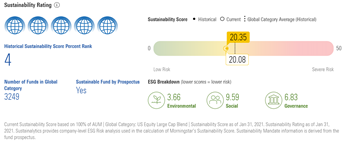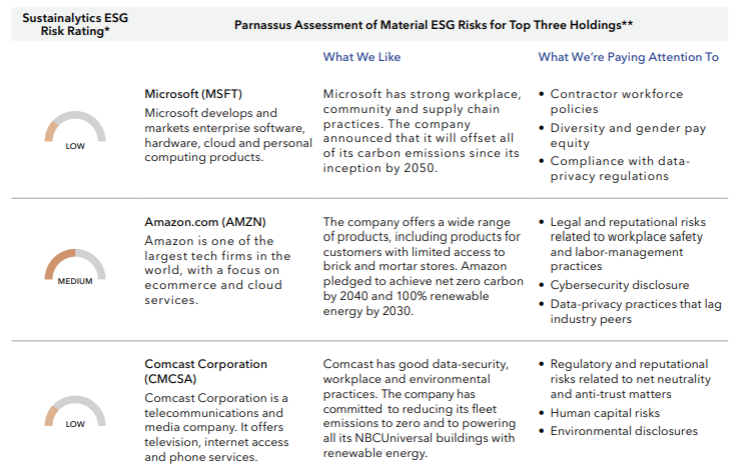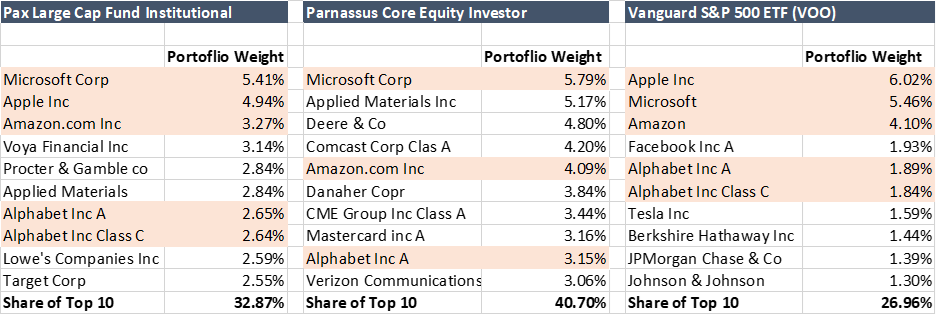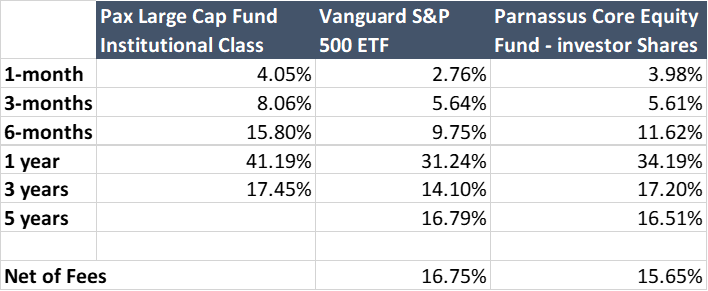I’ve been thinking about ESG funds since 2007. In fact, I wrote my senior thesis on socially-responsible stock indexes. I desperately want to believe that inclusion in a socially-screened investment fund can improve a stock’s performance and that directing investment to some firms over others, can reduce carbon emissions, improve working conditions, and create a more equitable world. Yet despite this desire, I find ESG comes up short. This post will talk about why I don’t invest in ESG funds which is an abbreviation for funds which use Environmental, Social, Governance criteria as a baseline for investing.
Every time that I reexamine the costs and benefits of ESG investing, I decide that the scope of the impact is not worth the additional expense. Here is a quick summary with more details below.
- ESG funds are generally much more expensive. I prefer passive-trading in ETFs or index funds with fees < 0.1%. Many socially-responsible funds charge fees which are >0.8%. Higher fees can translate to >$800K in difference in retirement. I would rather have those extra dollars in my pocket. I can use them to donate to causes and political candidates that will advocate for policies and provide social services that I believe in.
- The underlying investments in ESG funds often overlap heavily with those in traditional funds. While oil & gas companies may be excluded, technology companies whose ethical status are, at best, dubious, like Apple, Amazon, and Google, are over-represented.
- The companies that are chosen for investment may meet some socially-responsible criteria but not others. It’s relatively easy to exclude companies in the energy sector because of their reliance on fossil fuels. It’s harder to find companies that pay their people fairly, create safe working conditions, value diversity at the top, and reduce our footprint on the planet, etc.
Before I continue…
What are ESG funds?
ESG investing refers to funds which choose to invest (or not invest) in companies based upon a series of investing principles. As noted above, ESG stands for Environmental, Social, and Governance. These three criteria are used to measure if a company is a socially-responsible business. There are two main ways that ESG funds choose where to invest.
- Negative Screening: Some ESG funds may have negative screens where they exclude companies in certain sectors. For example, the FTSE4Good Index excludes companies which produce tobacco, weapons, and nuclear and biological weapons. In the energy sector, FTSE4Good excludes companies which product coal are left out. They will consider inclusion of oil and gas producers depending upon their commitment to green initiatives.
- Positive Screening: Some ESG funds require that a company go beyond NOT being in a harmful industry. Funds who focus on positive screening will outreach to companies to ask them about water usage, hazard pay during COVID, data disclosure, policies for hiring women and minorities, etc. Environmental, Social, and Governance are large categories that can refer to a variety of things. Each investment firm or index may define these criteria differently and they may change over time.
To give an example of positive screening related to “Social” performance, in 2021, Parnassus, an ESG leader, included Racial Equity in their February impact report. They sent 19 letters to companies requesting their Equal Employment Opportunity Data. While pressuring companies to think about and take a stand on Racial Equity is important, Parnassus praises FedEx and Guidewire’s CEOs for being “among the first business leaders to make public statements on their earning calls about the deaths of George Floyd, Ahmaud Arbery and Breonna Taylor that included calls to reject racism.” These public statements matter, but they are insufficient if they are not followed up by changes in hiring practices or efforts to reevaluate pay through a racial equity lens.
You have to dig deeper to discover if the ESG criteria align with your values and go far enough to really create societal change or environmental impact.
How can you evaluate an ESG fund?
Websites like Morningstar provide a vast array of investment research. They may also list a fund’s ESG ranking with a score related to environmental, social, and governance factors. Scores are on a scale of 1 to 10, and a lower score reflects lower risk in a category area. Below is an example of one of these ratings from Morningstar. You will have to dig deeper if you want to discover the variables that contributed to each score.

A fund’s website will provide more information. It will list data on the fund’s ESG standards and ratings, and may include details on recent initiatives. For example, Parnassus includes the below risk ratings for a few of its key holdings.

Pros and Cons of ESG Funds
For the sake of this analysis, I dove into two ESG funds and one “traditional” fund. I picked the two ESG funds from a list of the best ESG funds for socially-responsible investing. I picked two of these funds (neither the most expensive nor the least) and compared them to the Vanguard S&P 500 ETF (VOO) which is one of my favorite places to invest, and is an example of a passively traded Exchange-Traded Fund (ETF). The two funds I chose for comparison are Parnassus Core Equity Investor and Pax Large Cap Fund Institutional.
Comparing Parnassus Core Equity vs Pax Large Cap vs. VOO
I highlighted in light pink holdings that are similar.

- VOO is an index that tracks the top 500 firms in the US. It includes 509 large U.S. companies with a market cap of $194.18bn, yet 10 stocks represent 27% of its holdings. Of these, most are tech stocks. Interestingly, this top 10 has gotten “cleaner” over time. Tesla joined the S&P 500 in 2020 and already climbed into its top 10 listings. At the same time, Exxon dropped out of the top 10 in Q4 2019. Since there is no active picking of investments, VOO is able to charge a very low 0.03% / year expense ratio to investors in the fund.
- Pax Large Cap Fund Institutional (PXLIX) is an ESG fund. It started trading in 2017 as a low-carbon fund, and has a $250,000 minimum to invest. The fund includes investments in 46 equities. It charges an expense ratio of 0.7% / year to investors.
- Parnassus Core Equity Investor (PRBLX) is a second ESG fund. It has a $2,000 minimum investment and includes 41 equity investments. The fund is also a no fossil-fuel fund and does not invest in the energy sector. It charges an expense ratio of 0.86% / year to investors.
Comparison of “traditional” versus ESG / SRI holdings
Both Pax and Parnassus invest in less than 50 companies compared to 509 for VOO. This gives the ESG funds a lot more flexibility to exclude companies in dirty industries or with questionable labor practices. However, it is worth noting that 5 of Pax’s top 10 and 3 of Parnassus’ top 10 overlap directly with the 10 largest holdings in VOO. This links back to one of the main reasons that I opt out of SRI or ESG investing. The primary investments are NOT that different than “traditional” investing.
The three companies that appear in the indices of all three of the funds that I examined are Microsoft, Amazon, and Alphabet (aka Google). All three of these companies have had anti-trust rumors or active suits levied against them, and Amazon in particular has come under scrutiny for its treatment of workers both before and after COVID.
Furthermore, let’s dig into the differences between VOO and the two SRI / ESG funds. Both Pax and Parnassus include larger stakes in Applied Materials, a semiconductor company. Interestingly, if you invest in the S&P 500 you are also investing in Applied Materials. Its just a smaller percentage. As of February 2021, 0.33% of VOO’s holdings are Applied Materials versus 2.84% for PXLIX and 5.17% for Parnassus. The same goes for Procter & Gamble, Deere & Co, etc. You’re not gaining new companies to invest in. The main difference between a socially-responsible fund and “regular” S&P 500 stock index is what they choose NOT to invest in.
Cost of ESG Funds
The second reason that I don’t invest in ESG Funds is the cost. NerdWallet lists 10 of the best ESG funds. Only two have fees under 0.5%, and five have fees over 0.8%. Why does this matter? Let’s say your 30-years old and you have $75,000 saved for retirement. You plan to save $10,000 / year for retirement each year for the next 35 years, and have two investment options. One fund charges you an 0.8% expense ratio to invest your $75,000. That translates to a fee of $600 / year (0.008 x $75K). The other fund charges you an 0.04% expense ratio. That translates to a fee of only $30 / year (0.0004 x $75K). Fund Two can charge this low fee because it is passively traded. This means it tracks an index fund using an algorithm instead of an investment manager.
How does choosing the more expensive fund impact you?
Assuming both funds achieve the same 10% / year average performance, paying 0.8% / year in fees versus 0.04% translates to a difference of $876,712! Why? In addition to paying $570 more / year in fees in year one, you also lose out on the ability for that $570 to stay in your account and to earn interest. Furthermore, since the fee is charged as percentage of your assets, how much you pay increases as the value of your account grows. In this example, your fee in year two is not $600 but $655 since your base investment has grown from $75,000 to $81,900. The size of the fee will continue to grow.
How much you invest each year, your current nest egg, and the average market return are unknowns. However, fees are far from hypothetical. Going back to the three funds examined in this analysis, VOO has an expense ratio of 0.03% while Parnassus charges 0.86% and Pax charges 0.7%. In addition, Pax has a minimum investment of $250,000 which may place that more modest fee out of reach. Outside of ESG funds, fees are a key reason that I choose to roll over my old 401Ks. You can read more here.
I am wary of paying more for something without being certain about the value that it brings.
Performance of ESG Funds
You might be asking, but how do I know the performance is going to be the same? What if ESG funds perform better because companies who care about the environment and their workers perform better? While there is evidence that sustainably-traded indices perform better over time, the data is not conclusive.
Looking at the three funds in this analysis, the Pax fund only has 4-years of trading data. If you’re investing for retirement, you’re interested in returns over a 35-50 year period. While the ESG funds have beat VOO in individual years, VOO has performed slightly better than Parnassus (16.79% versus 16.51% over a 5-year period).
If this return is before and net of fees, then the Parnassus fund returned 15.65% versus 16.75% in VOO, more than a full percentage point worse. A 1% difference in return can translate to $1M over the course of 35 years so tread with caution.

Bottom Line
ESG funds are a good option for anyone wanting to divest from fossil fuels or wanting their money out of companies which produce tobacco or guns and other weapons. However, they come at a cost. As shown in the examples above, paying 0.8% or more in investment fees may translate to $800K+ in lost net worth.
While I am willing to pay more for products that are in line with my values, I am not content with the options that ESG investing present to me. I don’t blame the sustainable fund managers for investing in Google, Amazon, and Alphabet. These are three of the largest companies in the United States. Plus, they generate meaningful returns for their stakeholders. However, they are NOT paragons of morality.
Amazon and Apple receive many complaints about their labor practices and impact on small businesses. Similarly, Google and Microsoft have largely white-collar, well-compensated employees creating their technology products. Are the only companies worthy of capital those which by nature bypass some of our stickier labor and governance challenges?
Given my discontent with ESG funds, I would rather minimize the fees that I pay and use that extra retirement income to donate. I can give that money to non-profits providing low-cost healthcare and housing and politicians advocating for higher wages, safer working conditions, and cleaner water. How do you feel?
About me
I’m a former non-profit consultant and b corp employee passionate about trying to make the world a better place. ESG has been on my mind since at least 2007 when I chose this as a topic for my senior thesis at Georgetown University.
More broadly, I am passionate about financial education. After I received my MBA from one of America’s top business schools, I realized that even the most educated of us have little formal education about our personal finances. In 2020, I launched a series of online courses to make financial education cheaper and more accessible. My goal is to reduce the wealth gap and the fact that women own only $0.32 for every $1.00 owned by men. I would love for you to sign up for my email list or join me on instagram (@her.personal.finance) for more financial education.
